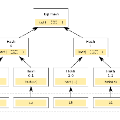This paper studies known indexing structures from a new point of view: minimisation of data exchange between an IoT device acting as a blockchain client and the blockchain server running a protocol suite that includes two Guy Fawkes protocols, PLS and SLVP. The PLS blockchain is not a cryptocurrency instrument; it is an immutable ledger offering guaranteed non-repudiation to low-power clients without use of public key crypto. The novelty of the situation is in the fact that every PLS client has to obtain a proof of absence in all blocks of the chain to which its counterparty does not contribute, and we show that it is possible without traversing the block's Merkle tree. We obtain weight statistics of a leaf path on a sparse Merkle tree theoretically, as our ground case. Using the theory we quantify the communication cost of a client interacting with the blockchain. We show that large savings can be achieved by providing a bitmap index of the tree compressed using Tunstall's method. We further show that even in the case of correlated access, as in two IoT devices posting messages for each other in consecutive blocks, it is possible to prevent compression degradation by re-randomising the IDs using a pseudorandom bijective function. We propose a low-cost function of this kind and evaluate its quality by simulation, using the avalanche criterion.
翻译:本文从一个新的角度研究已知的索引结构: 最小化IoT设备作为连锁客户端与包含两个 Guy Fawkes 协议、 PLS 和 SLVP 协议套件的块链服务器之间的数据交换。 PLS 块链不是一个加密货币工具; 它是一个无法变换的分类账, 向低能力客户提供保证的不可撤销性而不使用公用钥匙加密。 情况的新颖之处在于, 每个 PLS 客户都必须获得一个证据, 证明在其对手无法帮助的链条中的所有块中不存在数据交换; 我们显示, 在不翻转该块的Merkle树上, 这是可能的。 我们从理论上获取一个分散的Merkle树上叶条路的重量统计数据。 我们用一个理论来量化一个客户与链条互动的通信成本。 我们显示, 使用Tunstall 方法提供树木压缩的比特价指数可以实现大量节约。 我们进一步显示, 即使在相关访问的情况下, 在两个 IoT 设备中, 防止该区块的Merkle 树质量 设置一个标准, 我们用一个标准 来使用一个标准 来模拟模型 来显示, 。



